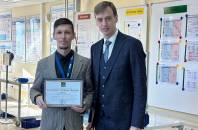|
Региональный журнал для деловых кругов Дальнего Востока
|
|
||||||||||||||||||||||
|
Вторник| 18 Ноября, 11:22 |
|
|
Тема номера
|
|||||||||||||||||||||

 Олег Кожемяко осуществил новогодние желания маленьких приморцев
В преддверии новогодних праздников заветные желания маленьких приморцев начинают сбываться. Так, Губернатор Приморского края Олег Кожемяко передал подарки от Деда Мороза двум маленьким приморцам: шестилетнему Мирону Глушаку из Тернейского муниципального округа и четырёхлетней Ольге Алимпиевой из Арсеньева.
Олег Кожемяко осуществил новогодние желания маленьких приморцев
В преддверии новогодних праздников заветные желания маленьких приморцев начинают сбываться. Так, Губернатор Приморского края Олег Кожемяко передал подарки от Деда Мороза двум маленьким приморцам: шестилетнему Мирону Глушаку из Тернейского муниципального округа и четырёхлетней Ольге Алимпиевой из Арсеньева.
 Родители ребят с ОВЗ обсудили вопросы образования и трудоустройства с представителями власти Приморья
Третья встреча клуба "На равных", призванного помогать гражданам решить непростые жизненные ситуации, состоялась в Приморье. В этот день участниками клуба стали родители детей с инвалидностью и ограниченными возможностями здоровья. Они обсудили с представителями власти вопросы образования и трудоустройства таких ребят.
Родители ребят с ОВЗ обсудили вопросы образования и трудоустройства с представителями власти Приморья
Третья встреча клуба "На равных", призванного помогать гражданам решить непростые жизненные ситуации, состоялась в Приморье. В этот день участниками клуба стали родители детей с инвалидностью и ограниченными возможностями здоровья. Они обсудили с представителями власти вопросы образования и трудоустройства таких ребят.
 Социальные предприниматели Приморья могут найти кадры и получить рекламу на радио при господдержке
Открыт прием заявок на две актуальные для социальных предпринимателей меры поддержки: "Размещение двух вакансий на HeadHunter" и "Размещение рекламы на радиостанции". Такой формат господдержки поможет социальному бизнесу Приморья продвигать свои услуги в осенний период и найти профессиональные кадры для расширения штата.
Социальные предприниматели Приморья могут найти кадры и получить рекламу на радио при господдержке
Открыт прием заявок на две актуальные для социальных предпринимателей меры поддержки: "Размещение двух вакансий на HeadHunter" и "Размещение рекламы на радиостанции". Такой формат господдержки поможет социальному бизнесу Приморья продвигать свои услуги в осенний период и найти профессиональные кадры для расширения штата.
 24 протокола составили на нарушителей противопожарного режима в приморских лесах
Лесничие и инспекторы в Приморье составили 24 протокола в отношении нарушителей особого противопожарного режима на землях лесного фонда. ОПР действует в большинстве муниципалитетов и подразумевает крупные штрафы за пренебрежение правилами пожарной безопасности.
24 протокола составили на нарушителей противопожарного режима в приморских лесах
Лесничие и инспекторы в Приморье составили 24 протокола в отношении нарушителей особого противопожарного режима на землях лесного фонда. ОПР действует в большинстве муниципалитетов и подразумевает крупные штрафы за пренебрежение правилами пожарной безопасности.
Tours in the Eastern Ring of Russia
By Tatiana SUSHENTSOVA,
Gleb ALENISHKO, Victor SHALAY
Time will tell how effective the project has been, but one thing is already clear: the RFE has tremendous potential as a tourist destination and finds a place in the heart of anyone who comes to know it better.
The Alps of the Kolyma
Three years ago, before my first assignment to the Magadan Region, my knowledge of it was limited to clichés: the land of permafrost, long polar nights and GULAG camps. In fact, it turned out to be quite different - emotional, full of color, and very friendly. Its northern beauty is subdued and sometimes rather austere, but it is also very honest and real.
Tourists who don’t know the region will find it hard to believe that the Kolyma is full of picturesque lakes, invigorating hot springs, and bountiful boreal forests - the famed taiga. Exciting walking hikes and skiing tours, extreme whitewater trips and reindeer sleigh and snowmobile rides, history tours of mines and gold mines, along with ethnographic and environmental tours bring this idea home.
Kolyma Alps is the name for several mountain ranges featuring Alpine landscapes. The view of Jack London Lake at an altitude of 800 meters is just as breathtaking as fishing on the Elikchan Lakes in the famous glacial valley, while ethnographic tours give you a good idea of the traditional lifestyles of the Evens, Chukchi, Koryaks and Eskimos. Extreme travel enthusiasts can take a raft down the challenging Kolyma River, or down the mysterious Sugoy or Kegali rivers, with snow rams and reindeer grazing on the banks. Those who want to improve their health as well as enjoy the stunning views of the Kolyma can visit the Tavatum hot springs to relieve back pain and alleviate rheumatism.
…Before going back home from my first trip here, I had the great good fortune of witnessing an aurora borealis - a rare event in the Kolyma (auroras are much more common in neighboring Chukotka). This rarity made my gift from Magadan nature all the more valuable and touching. Moreover, I had something to compare it with in my previous experience: I had witnessed an aurora borealis in Finnish Lapland, when it was merely a lovely extension of a magic fairy tale I had brought my little daughter to see. The sight was very different in the Kolyma - closer to home, if you will, and I got a very different “reading” from it: I saw the pain of the Kolyma, with its prison-camp history, in the mesmerizing flashes of color in the night sky, along with a stunning power, true beauty and vital force. After this, no doubts remained: the Kolyma truly is the heart of the Russian Northeast.
The breath of Sakhalin
You can feel the hot breath of Sakhalin at the South Sakhalin mud volcano, the largest in its region, which is triggered by a natural mechanism yet to be studied. A climb up Chekhov Peak, which commands a wonderful panoramic view, will inspire awe for the beauty and grandeur of Sakhalin nature even in the hearts of the most hardened skeptics. Those who dare take a three-week tour of Iturup, an “island of natural treasures,” get a chance to ride a boat into the crater of an extinct volcano, see a sunrise over the ocean, visit bird colonies, swim under a waterfall, catch fish and crab, and watch seals and sea lions going about their business; a chance to forget the hustle and bustle of daily life in the concrete-bound confines of the Megapolis and develop a strong love for this remote and unique island.
Chukotka Region as the starting point
Visiting this unique northern region full of stunning contrast is worth it, if only to be at the intersection of the 180th meridian and the Polar Circle - a spot of fantasy, a place out of time, where the line between “yesterday” and “tomorrow” blurs.
To see the real Chukotka, take a trip into the region’s remote areas, where you can still witness the old, traditional ways of the Chukchi, Koryaks, and Evens. Make sure you visit the Bay of the Cross, discovered by Vitus Bering, and the township of Egvekinot, one of the most picturesque spots in Chukotka and perhaps the best-protected bay in the Bering Sea, nestled cozily among the tall peaks. Egvekinot immediately destroys any misconceptions in the minds of those who might imagine Chukotka as featureless bare tundra.
Indeed, Chukotka is like a different planet, with an incredible magnetism all its own. This enchanted land, as local tour operators poetically describe it, pulls you in and makes you love it unquestioningly. It is hard to believe that the sky can be so poignantly blue, the tundra so lush and verdant, the polar night so starry, life so real.
You can also take an adventure-filled coastal cruise, visit bird colonies and walrus and seal beaches, take a dip in the hot springs, and get to know the locals - tough on the outside, but very kind and friendly people. If you have a chance, try playing the yarar - a traditional Chukchi tambourine, try roping in a reindeer with a tchat lasso, and stay the night in a real yaranga tent.
Warm welcome in Yakutia
“Come visit us - we’re having a warm spell here, just 35 below!” said an optimistic invitation to the International Conference for the Development of Event Tourism last December. Those who braved the cold and came to the forum left with myriad of unforgettable impressions of the exotic northern features.
The region is home to the Realm of Permafrost, the residence of Father Frost - the Russian version of Santa Claus, and Chyskhaan is the place where Russia’s favorite fairytale character, from Veliky Ustyug, takes the symbol of winter cold and carries it to other Russian regions, marking the official start of winter. This tourist project, called Winter Begins in Yakutia, has been celebrated in Yakutia for a number many years, attracting numerous visitors.
You can also celebrate the New Year in Yakutia in summer. Yakutia celebrates the traditional Yakut New Year - Ysyakh - in late June. This ethnic summer holiday lies at the heart of summer ethnographic tours, celebrating the end of the annual cycle (the word ‘ysyakh’ means ‘abundance, plenty’ in Yakut), and it is directly linked to the local Sun God and fertility cult. The happy, colorful celebration of the triumph of life and nature goes hand-in-hand with traditional prayer rites, plentiful refreshments, and kumys (fermented horse milk) drinking, dancing, traditional games and horse racing. Most importantly, the locals are happy to see visitors: according to tradition, the more people gather at Ysyakh, the more successful the coming year will be.
The Lena Pillars is a must-see sight for all visitors to Yakutia (the Lena Pillars were finally added to UNESCO World Heritage Site List in July). This amazing natural feature is a range of cliffs of unique and very interesting shapes. Natural stone figures line the banks of the Lena River for tens of kilometers, attracting large numbers of tourists amazed by the stunning natural beauty. This is also the location of the Diring-Yuriakh pre-historic camping site, considered one of the oldest in the world.
In the Amur River prairies
People visit the nature parks of the Amur River banks to watch the cranes - the area is home to six of the seven species of crane found in Russia. This is also where annual contests and festivals - Crane Dawn, Saying Goodbye to Cranes and the International Birding Day - take place.
The State Khingan Nature Preserve stands where the terrace plains of the mid-stream Amur rise to the foothills of Lesser Khingan. This area still has the typical untouched Amur landscape - the East Asian prairies. You can see picturesque grasslands and forest-grassland landscapes in the preserve, and you can chance upon the nests of Daurian and Ussury cranes and watch Kamarov’s Lotus - a real Far Eastern gem - on Lake Dolgoye from mid-July through mid-August.
The region also has a number of archeological sites. One place of interest is the so-called dinosaur cemetery at Kundur, where more than 1,000 dinosaur bones have been found. In fact, a dinosaur species previously unknown to science was given the name “Amursaurus.”
The Eveni Village Ethnographic Center opened in the Tynda District of the Amur Region last spring, depicting the daily life and traditions of this native northern ethnic group. You can feed the reindeer here, take a peek inside an Eveni tent, visit a traditional crafts shop, taste traditional Eveni cuisine, fish on northern rivers in summer, and ride a snowmobile in winter.
Amazing Kamchatka
Yuri Senkevich, a Soviet explorer and long-running global geography TV show host, said in an interview shortly before his death that of all places on Earth, Kamchatka impressed him the most. Coming from an experienced traveler and explorer who had traveled the globe, this means a great deal.
Tourist opportunities in the region are highly diverse: from hotel stays with a busy tour schedule, to personal guided hunting and fishing trips, horseback and birding trips, trekking and rafting, as well as Avacha Bay cruises and underwater sports, extreme skiing expeditions and heliskiing on volcano slopes.
Kamchatka features about 14,000 rivers and streams, around 100,000 lakes, 414 glaciers, 274 mineral water springs, some 40 species of wild game, and all Pacific salmon species (with some fish weighing up to 40 kilograms, or 100 lb!). This makes Kamchatka Peninsula a paradise for fishing and hunting enthusiasts, with the brown bear as the most prized trophy, reaching its largest size in Eurasia.
Visitors to Geyser Valley feel most exclusive, witnesses to a rare natural phenomenon in action: the “work” of many geysers; you feel the hot breath of a great subterranean “boiler room” propelling thousands of cubic meters of hot water and steam into the atmosphere at regular intervals. Every natural phenomenon has a role in this flamboyant natural show. Hot-water lakes, boiling mud pots and springs; it took nature took hundreds of thousands of years to create this unique tableau, and it is no accident that Geyser Valley is part of UNESCO’s Kamchatka Volcanoes world cultural and natural heritage site.
Discovering the Khabarovsk Region
There is an amazing spot in the Khabarovsk Region where it is easy to feel like a true explorer. However, nothing about the trip itself is easy - the trip to Shantary is extreme: warm currents never reach it, here on the southern corner of the Sea of Okhotsk; thick fog alternates with heavy storms; icebergs are sighted near the coast even in summer; and whales, orcas and brown bears the are masters of this wild, inaccessible and incredibly beautiful area. The lack of easy access, and the nature untouched by civilization have made this a realm of primordial nature. According to the few adventure travelers who do make it here - Shantary sees only a few dozen visitors every year - the fishing is so good that it is easy to lose interest. But this does not bother the brown bears, who live here in record numbers. You can see whales off the islands in summer, and schools of orcas come here to hunt seals.
Another place of note is the Dusse-Alin mountain range, one of the tallest in the RFE, which has retained most of its untouched wildlife and nature. Few tourists can say they have been there, as you must cover 120 kilometers on foot to enjoy the magnificent mountain lakes. The striking views, incredible silence, crystal clear air and fragrant wild grasses and moss are a good way to take a break from our hectic modern life. Late summer and early fall are the best times to explore the Dusse-Alin’s beauty, but winter also gives it a special charm. When the weather is warm, most tourists make the trip back on inflatable catamarans on the Left Bureia River, feeling very much a part of pristine nature.
Primorsky Region gets its second wind
Clearly, Primorsky Region’s tourism is getting its second wind: it is enough to see the new symbols of Vladivostok - the bridges spanning Golden Horn Bay and the Eastern Bosporus Strait, as well as other structures and complexes built for the APEC Summit.
Another benefit for the host city of this year’s APEC Summit is that it has made people curious about tourist programs and attractions which have been available for years. Tours dedicated to the role of Koreans in Vladivostok’s history have been attracting visitors from South Korea for many years. They get a unique opportunity to follow the progress of their ancestors; find out more about their lives, ambitions and hopes; learn about the complex and interesting interactions between Korean settlers and Russian residents of the city; and honor the memory of those lived in New Korea Town in Vladivostok.
Petrov Island attracts people with the incredible mystical aura hanging over its lands, especially the famous Yew tree Grove. According to legend, the grove was planted by Yolu sea brigands and served them as a place of worship. The trees in the grove are planted in precise order, forming six or seven hieroglyphic characters. Nobody has been able to translate the message written in planted trees. The large and amazingly beautiful Singing Sands Bay, as the locals call it, faces the island from the mainland. The pure white sand, gently receding seabed, crystal clear water transparent to a depth of 30 meters, and the solitude ensured by Lazo Nature Preserve make immersion in the legend an unforgettable experience.
Or visit the Pidan and Falaza mountains, wrapped in a shroud of ancient mystery! Come see the fortifications of Vladivostok Fortress, including the smallest and most accessible of them all - Prince Alexis Fort No. 7. Conveniently located for tourists who do not have much time, the fortress provides insights into the history of one of the world’s best naval fortresses.
Finally, make sure you spend time by the sea. Primorsky Region is home to Russia’s only maritime nature preserve. Walk on the beach, gaze off to the horizon. The Pacific Ocean is immense, and you can sense its vast expanse in the thick, moist air carried here with the waves from hundreds of kilometers offshore. Forget about work; recall instead for your home towns and cities, which are more distant from Primorye than the lands linking Europe and Asia. Make a wish and say “you’re welcome” in response to the barely audible words of thanks carried here on the wind, on the rustle of beach gravel, the words Primorye whispers to anyone bold enough to visit.
- Дальневосточный фокус. Как делать бизнес на Дальнем Востоке?
- Дрейф в штиль. Куда идет дальневосточный бизнес
- Акцент на береговую зону
- "РЖД" берет повышенный план
- Банки сняли отраслевые барьеры малому бизнесу на Дальнем Востоке
- Рейтинг 100 крупнейших компаний Дальнего Востока по выручке и темпам роста показывает реальные дела
- Рецепты выживания: Рейтинг эффективности бизнеса 100 крупнейших компаний Дальнего Востока
- По "Улице Дальнего Востока" с любопытством и восторгом
- Проект "Приморский маршрут": Приморский край: есть чем впечатлиться
- ТОП крупнейших компаний Дальнего Востока расширился до 150
 #ПозывнойКультура: Дед Мороз поздравил участников СВО в госпитале ТОФ с наступающим Новым годом
В преддверии Нового года агитбригада #ПозывнойКультура побывала в госпитале Тихоокеанского флота в субботу, 28 декабря. Для участников СВО, находящихся на лечении и реабилитации, прозвучали музыкальные поздравления. Со словами самых теплых пожеланий подарки военнослужащим вручила заместитель Председателя Правительства Приморского края – министр культуры и архивного дела Елена Бронникова.
#ПозывнойКультура: Дед Мороз поздравил участников СВО в госпитале ТОФ с наступающим Новым годом
В преддверии Нового года агитбригада #ПозывнойКультура побывала в госпитале Тихоокеанского флота в субботу, 28 декабря. Для участников СВО, находящихся на лечении и реабилитации, прозвучали музыкальные поздравления. Со словами самых теплых пожеланий подарки военнослужащим вручила заместитель Председателя Правительства Приморского края – министр культуры и архивного дела Елена Бронникова.
 Губернатор Приморья оценил оснащение Индустриального колледжа в Арсеньеве
Очередной день работы Губернатора Приморского края Олега Кожемяко в муниципалитетах региона начался с посещения Приморского индустриального колледжа в Арсеньеве. Глава региона изучил новое оборудование, на котором готовят специалистов технических специальностей.
Губернатор Приморья оценил оснащение Индустриального колледжа в Арсеньеве
Очередной день работы Губернатора Приморского края Олега Кожемяко в муниципалитетах региона начался с посещения Приморского индустриального колледжа в Арсеньеве. Глава региона изучил новое оборудование, на котором готовят специалистов технических специальностей.
 Комплекты быстровозводимых мостов начали поставлять в Приморье
Началась поставка средних автодорожных разборных мостов (САРМ) для проведения аварийно-восстановительных работ на дорогах Приморья. Всего на следующий год закуплено 11 комплектов. При необходимости комплекты САРМ будут использованы для оперативного восстановления проездов во время паводков.
Комплекты быстровозводимых мостов начали поставлять в Приморье
Началась поставка средних автодорожных разборных мостов (САРМ) для проведения аварийно-восстановительных работ на дорогах Приморья. Всего на следующий год закуплено 11 комплектов. При необходимости комплекты САРМ будут использованы для оперативного восстановления проездов во время паводков.
 Почти 900 сотрудников предприятий Приморья уже владеют бережливыми технологиями благодаря нацпроекту "Производительность труда"
Итоги реализации национального проекта "Производительность труда" и планы на будущее озвучил министр экономического развития Приморья Андрей Блохин на награждении команды Регионального центра компетенций. За четыре года работы нацпроекта реализовано 78 проектов по внедрению бережливых технологий на предприятиях края.
Почти 900 сотрудников предприятий Приморья уже владеют бережливыми технологиями благодаря нацпроекту "Производительность труда"
Итоги реализации национального проекта "Производительность труда" и планы на будущее озвучил министр экономического развития Приморья Андрей Блохин на награждении команды Регионального центра компетенций. За четыре года работы нацпроекта реализовано 78 проектов по внедрению бережливых технологий на предприятиях края.


